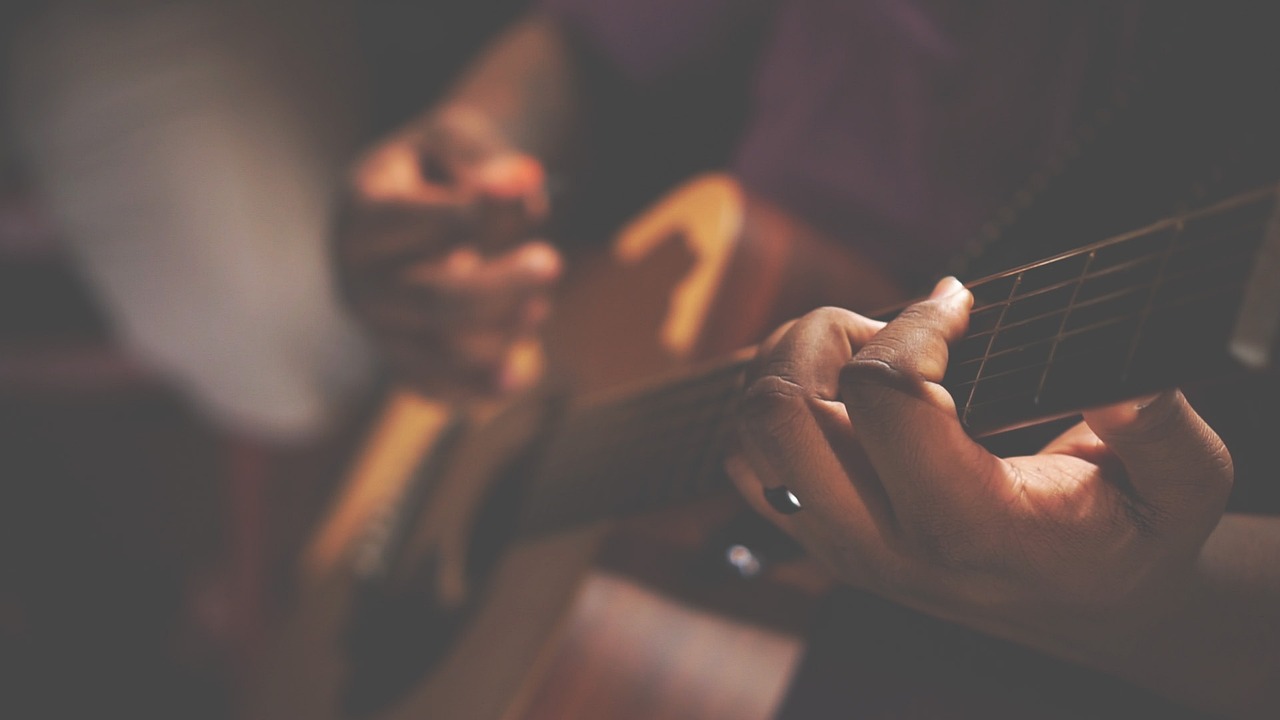This article contains affiliate links. Learn more.
The journey of learning to play the guitar begins with selecting the right instrument. For beginners, this choice can seem overwhelming given the vast array of options available on the market. From body styles and wood types to pickups and price points, numerous factors influence which guitar will best suit your needs.
This comprehensive guide aims to demystify the process of choosing your first guitar. We’ll explore the fundamental differences between acoustic and electric guitars, examine key considerations when making your selection, and highlight some of the best beginner-friendly models in both categories. By the end of this article, you’ll have the knowledge needed to make an informed decision about which guitar will be the perfect companion for your musical journey.
Remember, the right guitar isn’t necessarily the most expensive or the one your favorite musician plays—it’s the one that inspires you to pick it up and play every day.
Table of Contents
- 1 Understanding Your Goals: The First Step in Choosing a Guitar
- 2 The Fundamental Difference Between Acoustic and Electric Guitars
- 3 Essential Features to Consider When Choosing a Guitar
- 4 Best Acoustic Guitars for Beginners
- 5 Best Electric Guitars for Beginners
- 6 Choosing Between Acoustic and Electric: Key Considerations
- 7 Essential Accessories for New Guitarists
- 8 Learning Resources for Beginning Guitarists
- 9 Common Mistakes Beginners Make When Choosing Their First Guitar
- 10 Caring for Your New Guitar
- 11 Finding Your Sound: Developing as a Guitarist
- 12 Conclusion: Making Your Decision
Understanding Your Goals: The First Step in Choosing a Guitar
Before diving into specific guitar recommendations, it’s essential to consider what you hope to achieve with your instrument. Your musical goals will significantly influence which type of guitar will serve you best.
Assessing Your Musical Preferences
Take a moment to reflect on the music that inspires you. Which artists do you admire? What genres do you enjoy listening to most? If you’re drawn to folk, country, or singer-songwriter styles, an acoustic guitar might be your best starting point. If rock, metal, or blues ignites your passion, an electric guitar could be more appropriate.
Remember that while certain styles traditionally favor one type of guitar, there are no strict rules. Many acclaimed musicians have defied conventions, creating unique sounds by using instruments in unexpected ways.
Considering Your Learning Environment
Your living situation is another crucial factor to consider. Do you live in an apartment with thin walls and noise-sensitive neighbors? Do you plan to practice late at night? If noise concerns are significant, an electric guitar paired with headphones might be the more considerate choice, allowing you to practice at any hour without disturbing others.
Conversely, if you want the freedom to play anywhere without requiring amplification or power sources, an acoustic guitar offers unmatched portability and convenience.
Thinking About Your Budget
While we won’t discuss specific prices in this guide, it’s important to acknowledge that your budget will influence your options. Both quality acoustic and electric guitars are available at various price points, but the initial investment differs between these categories.
When budgeting for an electric guitar, remember to account for essential accessories like an amplifier, which represents an additional cost beyond the instrument itself. Acoustic guitars generally require fewer accessories to get started, potentially making them more economical as a first instrument.
The Fundamental Difference Between Acoustic and Electric Guitars
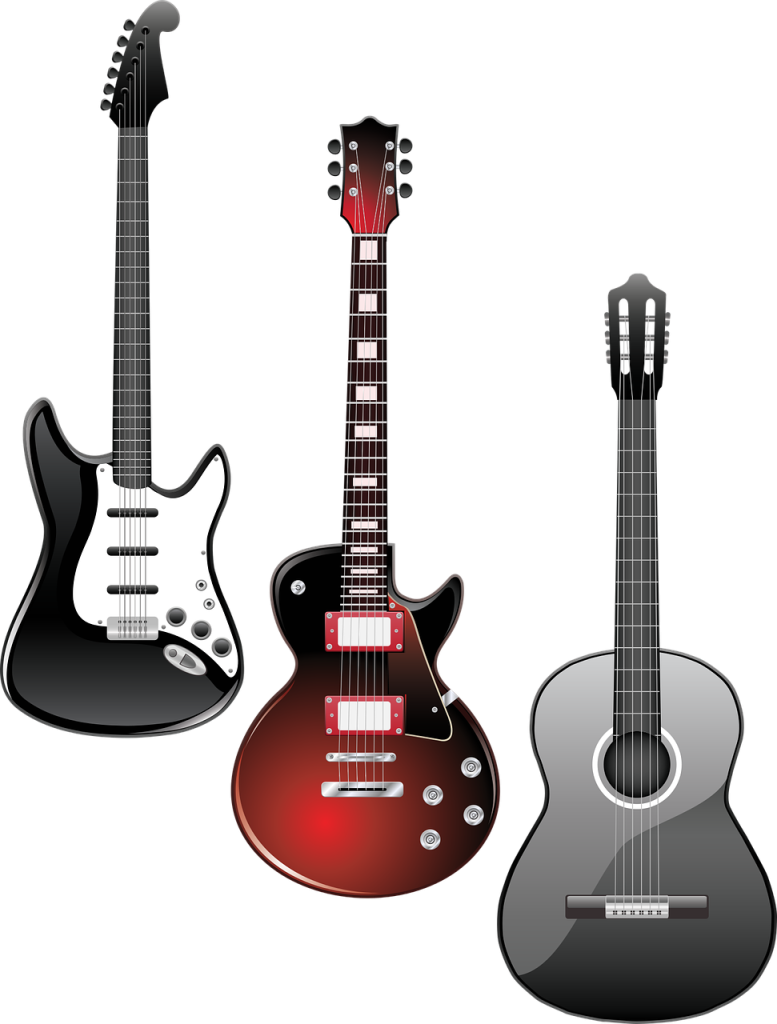
One of the most important decisions beginners face is choosing between acoustic and electric guitars. Let’s explore the key differences between these two primary categories to help you determine which aligns better with your needs and preferences.
Acoustic Guitars: Natural Projection and Versatility
Acoustic guitars produce sound through the natural resonance of the strings vibrating against the hollow body of the instrument. This design gives acoustic guitars their distinctive warm, rich tone and allows them to be played without any external amplification.
Design and Construction
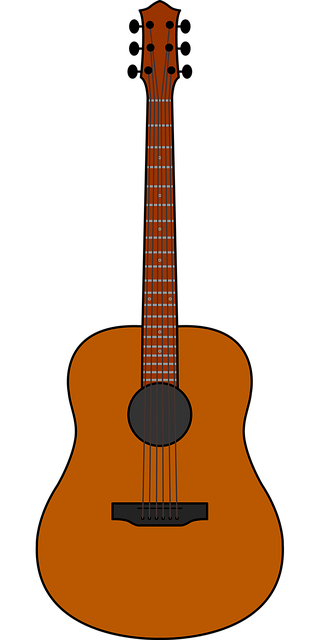
Acoustic guitars feature a hollow body with a soundhole in the center, which projects the sound created by the vibrating strings. The body shape, wood type, and construction quality all influence the instrument’s tonal characteristics.
Common acoustic guitar body styles include:
- Dreadnought: The most popular acoustic guitar shape, known for its balanced tone and strong projection. Dreadnoughts are versatile instruments that work well for strumming chords and flatpicking.
- Concert/Auditorium: Smaller than dreadnoughts, these guitars offer greater comfort for some players while maintaining good volume and balanced sound.
- Jumbo: Larger guitars that produce a bold, resonant sound with enhanced bass response, favored by many strummers.
- Parlor: Compact guitars with a focused, mid-range tone that works well for fingerstyle playing.
Playing Experience
For beginners, acoustic guitars present some unique challenges and benefits:
- String Tension: Acoustic guitars typically have heavier strings and higher tension than electric guitars, which can make fretting notes more challenging for beginners and may cause finger soreness during the initial learning period.
- Action Height: The “action” (distance between strings and fretboard) is often higher on acoustic guitars, requiring more finger strength to press the strings down properly.
- Immediate Feedback: Acoustic guitars provide instant sound without any setup, allowing beginners to start playing immediately without worrying about amplifiers or settings.
Best Suited For
Acoustic guitars excel for:
- Solo performances
- Singer-songwriters
- Campfire jam sessions
- Folk, country, and bluegrass styles
- Players who value simplicity and portability
Electric Guitars: Versatile Tones and Easier Playability
Electric guitars rely on electronic pickups to convert string vibrations into electrical signals, which are then amplified through a speaker. This design allows for a wide range of tonal possibilities and generally offers a more forgiving playing experience for beginners.
Design and Construction
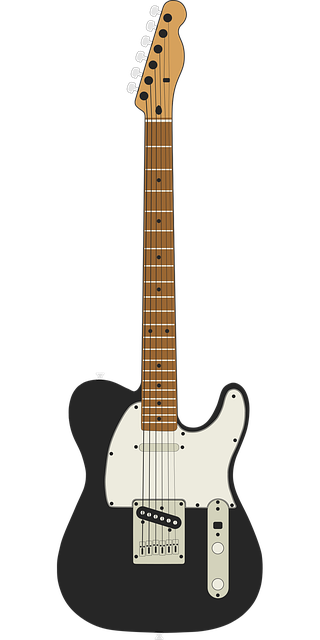
Electric guitars typically feature a solid body, though semi-hollow and hollow-body variations exist. Key components include:
- Pickups: Electromagnetic devices that capture string vibrations. Different pickup types (single-coil, humbucker, P90) produce different tonal characteristics.
- Controls: Knobs and switches that allow players to adjust volume and tone, as well as select different pickups for varied sounds.
- Bridge Systems: From fixed bridges to tremolo systems (whammy bars) that allow for pitch manipulation.
Common electric guitar body styles include:
- Stratocaster-style: Featuring a double-cutaway design for easy access to upper frets, these guitars typically offer versatile tones suitable for many genres.
- Telecaster-style: Known for their distinctive single-cutaway shape and twangy sound, these guitars are prized for their simplicity and reliability.
- Les Paul-style: Featuring a single-cutaway design and typically equipped with humbucker pickups, these guitars offer a thicker, warmer tone favored by many rock and blues players.
- SG-style: Lightweight guitars with a double-cutaway design that provides exceptional access to upper frets.
Playing Experience
Electric guitars offer several advantages for beginners:
- Lower String Tension: Electric guitars typically use lighter gauge strings with lower tension, making them easier to press down and bend.
- Lower Action: The strings are usually closer to the fretboard, requiring less finger strength to fret notes clearly.
- Slimmer Neck Profiles: Many electric guitars feature thinner necks that are easier for smaller hands to navigate.
- Volume Control: The ability to practice quietly with headphones can be a significant advantage for beginners concerned about disturbing others.
Best Suited For
Electric guitars excel for:
- Rock, blues, metal, and jazz styles
- Players interested in exploring effects and varied tones
- Those who might have difficulty pressing down acoustic strings
- Situations where volume control is important
A Note on Acoustic-Electric Guitars
Acoustic-electric guitars represent a hybrid approach, combining the natural sound of an acoustic guitar with the amplification capabilities of an electric. These instruments feature built-in pickups and preamp systems that allow them to be plugged directly into an amplifier or PA system.
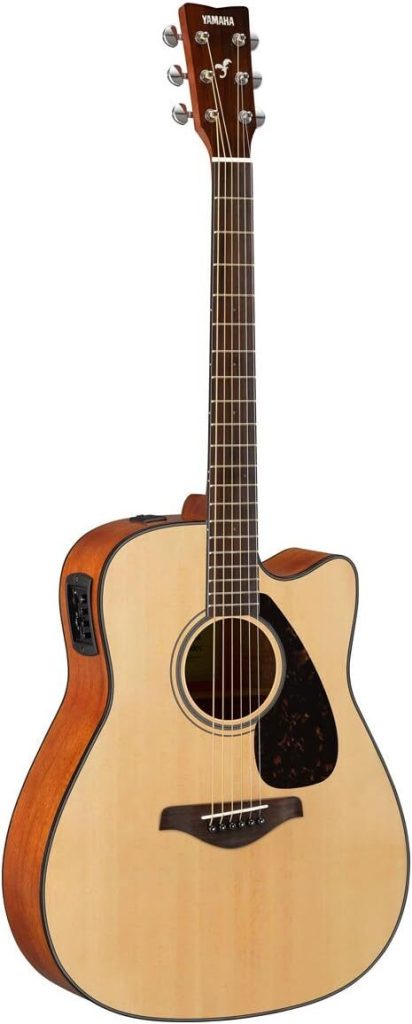
Shown above: Yamaha FGX800C Acoustic-Electric Guitar
For beginners who are primarily interested in acoustic sounds but anticipate performing in amplified settings in the future, an acoustic-electric might be worth considering. However, for most beginners, a standard acoustic or electric guitar will be more than sufficient to start the learning journey.
Essential Features to Consider When Choosing a Guitar
Whether you’re leaning toward an acoustic or electric guitar, several key features will impact your playing experience. Understanding these elements will help you make a more informed decision when selecting your instrument.
Body Size and Comfort
The physical dimensions of a guitar significantly affect both its sound and playability. Larger acoustic guitars typically produce more volume and bass response, while smaller instruments often offer greater comfort, especially for younger players or those with smaller frames.
When trying out guitars, pay attention to how the instrument feels against your body. Can you comfortably reach around the body to strum? Does the weight feel manageable for extended playing sessions? These comfort factors are crucial for ensuring you’ll want to pick up your guitar regularly.
For younger beginners or players with smaller builds, consider:
- 3/4 size or parlor guitars for acoustics
- Shorter scale length electric guitars
- Lighter body styles that reduce strain during practice sessions
Neck Profile and Width
The shape and dimensions of a guitar’s neck can dramatically impact playability, especially for beginners. Neck profiles (the shape of the back of the neck) range from C-shaped (the most common and generally comfortable for most players) to V-shaped or U-shaped designs.
Neck width also varies, with classical and some acoustic guitars featuring wider necks that provide more space between strings, while many electric guitars have narrower necks that some beginners find easier to navigate.
When possible, try guitars with different neck profiles and widths to determine which feels most natural in your hand. Remember that what works best will depend on your hand size and personal preference.
Tonewoods and Construction Quality
The materials used in a guitar’s construction significantly influence its sound, durability, and price. While high-end guitars often feature exotic hardwoods, many excellent beginner instruments use quality alternatives that offer good sound at more accessible price points.
Common tonewoods include:
For acoustic guitars:
- Spruce: Commonly used for tops, offering bright, dynamic sound with good projection
- Cedar: Provides a warmer, more responsive tone that works well for fingerstyle playing
- Mahogany: Often used for backs and sides, adding warmth and midrange focus
- Maple: Contributes clarity and definition, with strong treble response
For electric guitars:
- Alder: Balanced tone with slight emphasis on upper midrange
- Ash: Bright, resonant sound with good sustain
- Mahogany: Warm, rich tone with strong bass and midrange
- Maple: Often used for necks and as a top wood, adding brightness and definition
While tonewoods matter, for beginners, construction quality is generally more important than specific wood types. A well-built guitar made from quality materials will provide a better playing experience than a poorly constructed instrument using premium woods.
Hardware Quality
The quality of a guitar’s hardware—including tuning machines, bridge, and nut—directly affects tuning stability and overall playability. For beginners, tuning stability is particularly important, as constantly retuning your instrument can be frustrating and disruptive to the learning process.
Look for:
- Smooth, precise tuning machines that hold tension well
- A properly cut nut that allows strings to move freely without binding
- A solid bridge that transfers string vibration effectively to the body
While entry-level guitars may not feature the highest-end hardware, many beginner-focused instruments now come with surprisingly good components that provide reliable performance.
Fretwork and Setup
One of the most critical yet often overlooked aspects of a guitar’s playability is the quality of its fretwork and setup. Even an otherwise well-made guitar can be challenging to play if the frets are uneven or the action (string height) is improperly adjusted.
Signs of good fretwork include:
- Smooth fret ends that don’t protrude from the edge of the fretboard
- Consistent fret height across the neck
- No buzzing when playing notes on various positions of the neck
Many reputable retailers include a basic setup with the purchase of a new guitar. If possible, have an experienced player or technician evaluate any instrument you’re considering to ensure it’s properly set up for optimal playability.
Best Acoustic Guitars for Beginners
When selecting your first acoustic guitar, focus on instruments that offer a balance of playability, sound quality, and durability. Here are some top contenders in the beginner acoustic guitar category:
Yamaha FG800
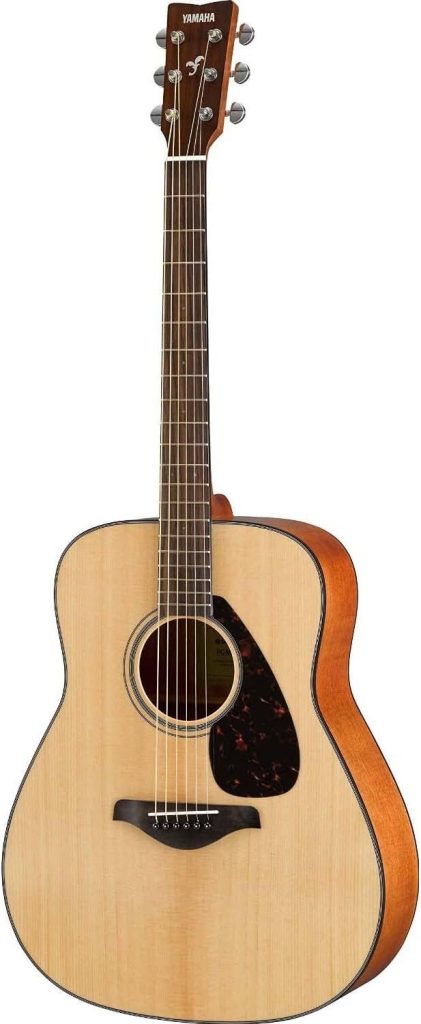
The Yamaha FG800 has established itself as a benchmark for quality entry-level acoustic guitars. This dreadnought model features a solid spruce top with nato/okume back and sides, delivering impressive projection and a balanced tonal palette that works well across multiple playing styles.
What makes the FG800 particularly suitable for beginners:
- Solid spruce top provides better resonance than many guitars in its class
- Comfortable neck profile suits a range of hand sizes
- Excellent build quality ensures longevity as skills develop
- Balanced tone works well for both strumming and fingerpicking
Fender CD-60S
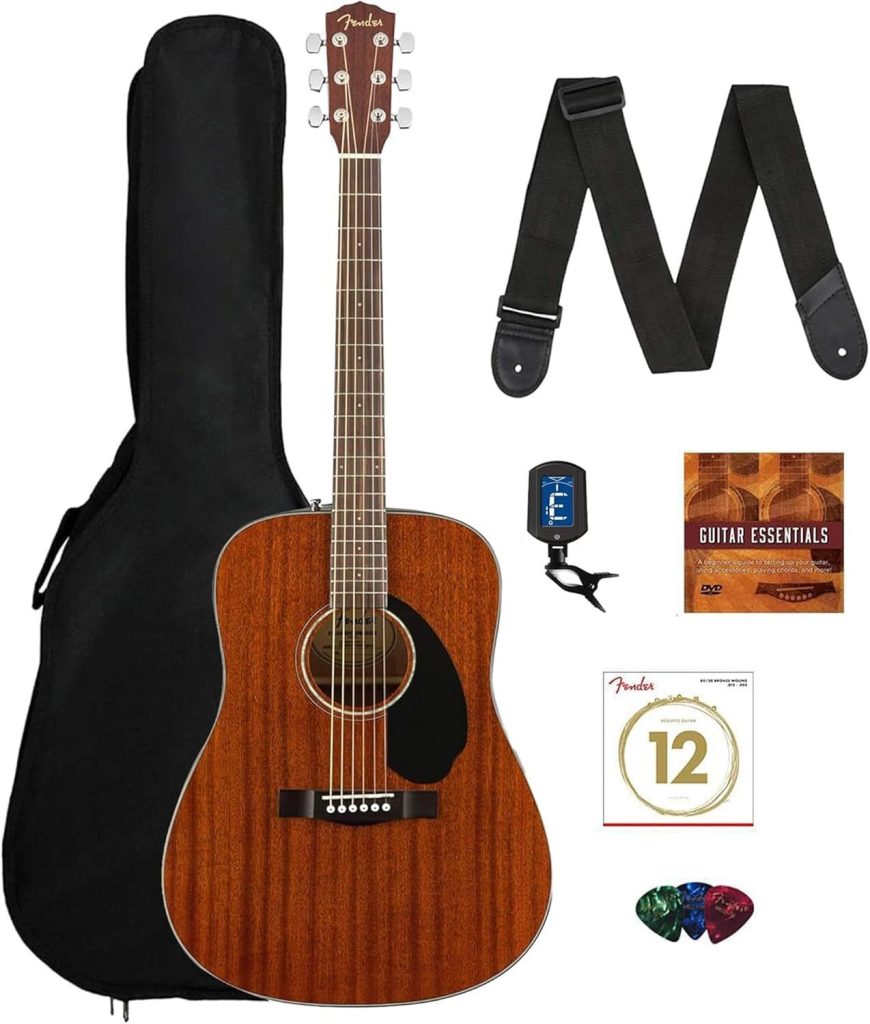
Fender’s CD-60S dreadnought combines accessible playability with solid construction. Featuring a solid spruce top and mahogany back and sides, this guitar produces a warm, rich tone that’s inspiring for new players.
Beginner-friendly features include:
- Easy-playing neck with rolled fingerboard edges for comfort
- Scalloped X-bracing enhances projection and bass response
- Quality die-cast tuners provide good tuning stability
- Available in a variety of finishes to suit personal taste
Taylor Academy 10
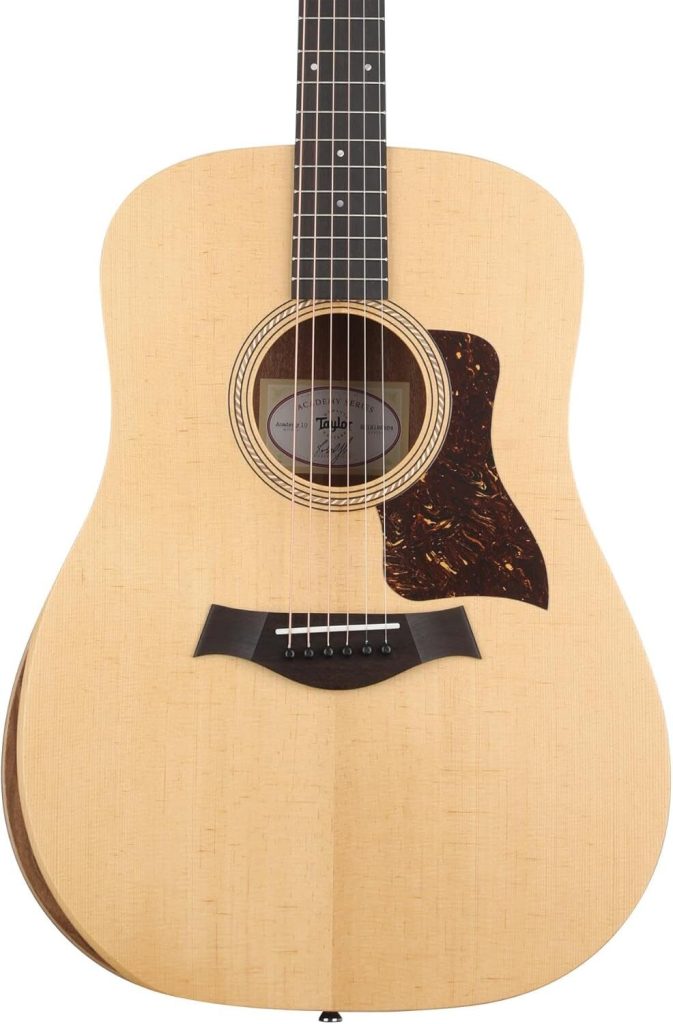
For beginners with a slightly higher budget, the Taylor Academy 10 offers exceptional playability and sound quality. This guitar features Taylor’s patented neck design and includes an armrest to enhance comfort during practice sessions.
Standout features include:
- Specially designed for beginners without compromising sound quality
- Ergonomic armrest reduces playing fatigue
- Narrower nut width (1-11/16″) makes chord formations easier for beginners
- Layered sapele back and sides with solid sitka spruce top
Martin LX1 Little Martin
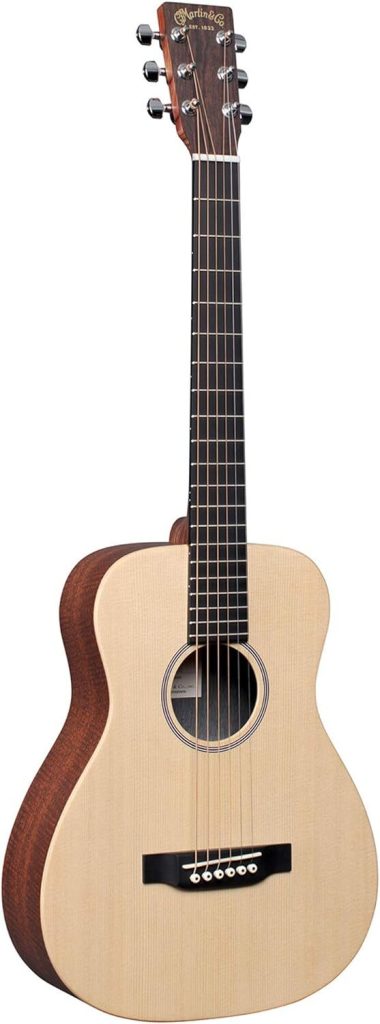
The Martin LX1, often referred to as the Little Martin, is a 3/4 size guitar that’s perfect for younger players or adults seeking a more compact instrument. Despite its smaller size, this guitar offers the renowned Martin tone and quality construction.
Benefits for beginners:
- Compact size makes it ideal for smaller players or travel
- Comfortable neck profile suits beginners
- Surprisingly full sound despite the smaller body
- High-pressure laminate body provides durability for active beginners
Seagull S6 Original
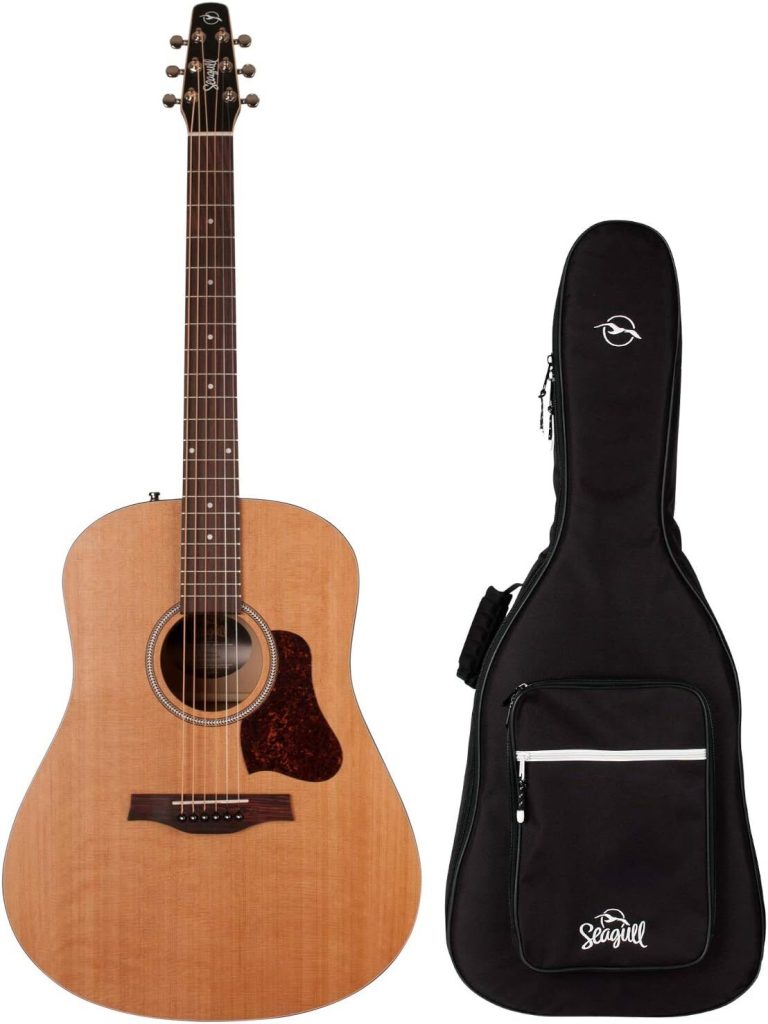
The Seagull S6 Original stands out for its exceptional build quality and distinctive voice. Made in Canada, this guitar features a solid cedar top and wild cherry back and sides, creating a warm, balanced tone that responds well to various playing techniques.
What beginners will appreciate:
- Slightly wider nut width (1.8″) provides more space for accurate finger placement
- Distinctive headstock design improves tuning stability
- Pressure-tested solid cedar top ensures quality sound
- Compound curved top enhances structural integrity and projection
Ibanez AW54OPN
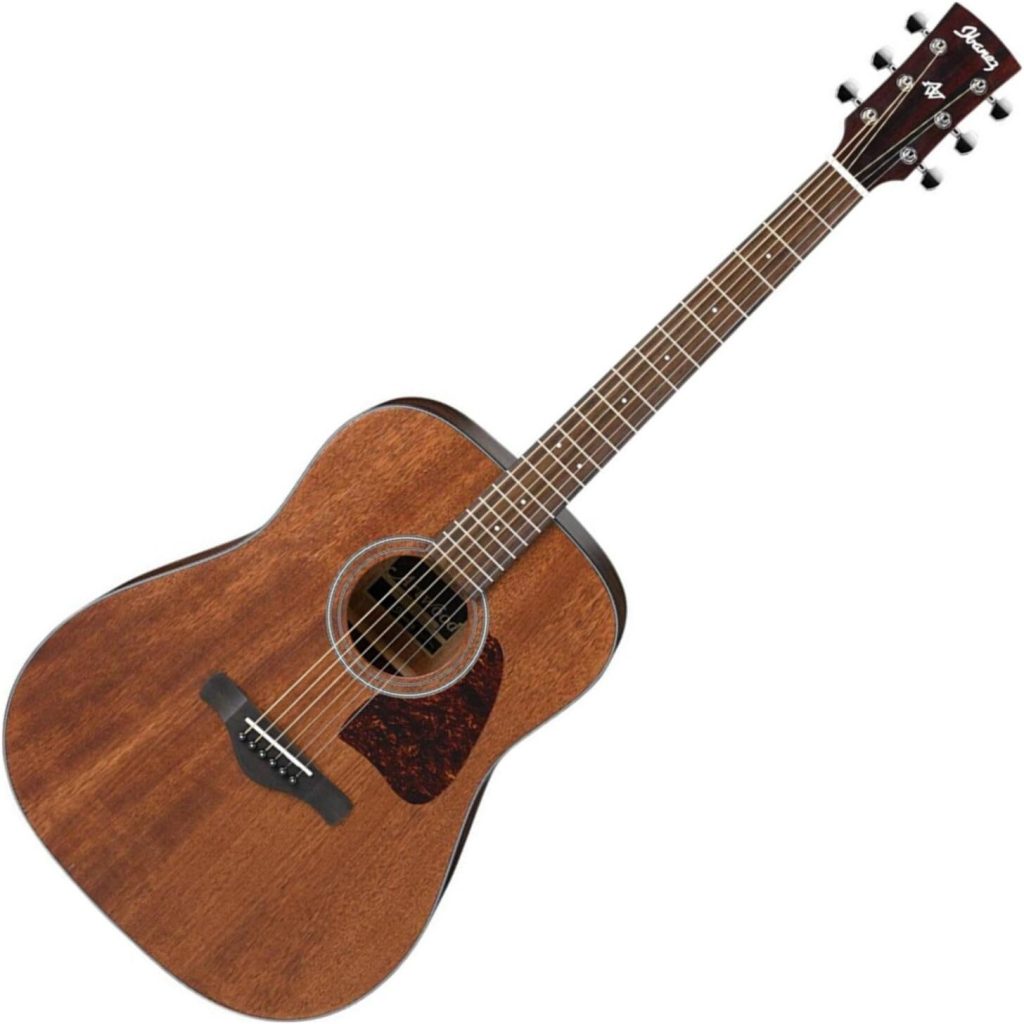
The Ibanez AW54OPN offers a different tonal palette with its all-mahogany construction. This dreadnought features a solid mahogany top that produces a warm, focused sound with strong midrange presence.
Features beneficial for beginners:
- Comfortable C-shaped neck profile
- Open pore natural finish allows the wood to breathe and vibrate more freely
- Chrome die-cast tuners provide reliable tuning stability
- Warm tone that’s particularly well-suited to blues and folk styles
Epiphone DR-100
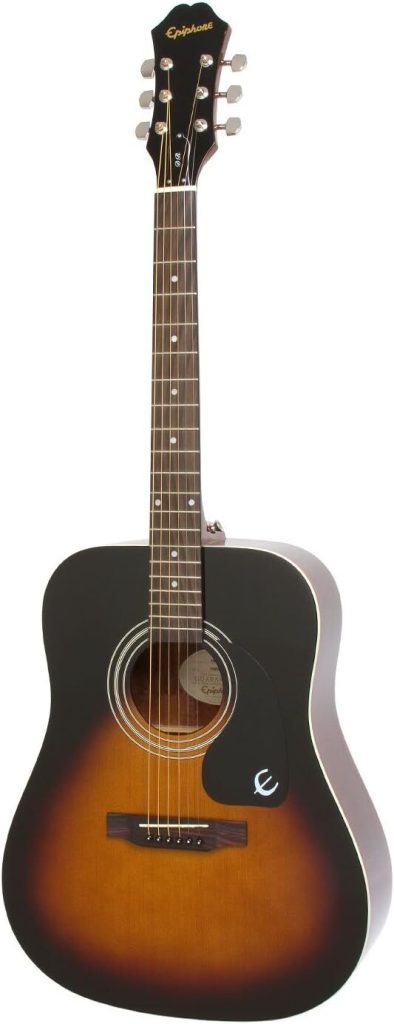
The Epiphone DR-100 represents one of the most affordable quality options for beginners. This dreadnought features a select spruce top with mahogany back and sides, delivering a balanced sound that works well across musical styles.
Why it’s good for beginners:
- Affordable without significant quality compromises
- SlimTaper neck profile is comfortable for new players
- Available in multiple finishes to suit personal preference
- Robust construction stands up to the rigors of learning
Best Electric Guitars for Beginners
Electric guitars offer tremendous versatility and are often easier to play than acoustics due to their typically lower action and lighter strings. Here are some top recommendations for beginners entering the electric guitar world:
Squier Classic Vibe ’50s Stratocaster
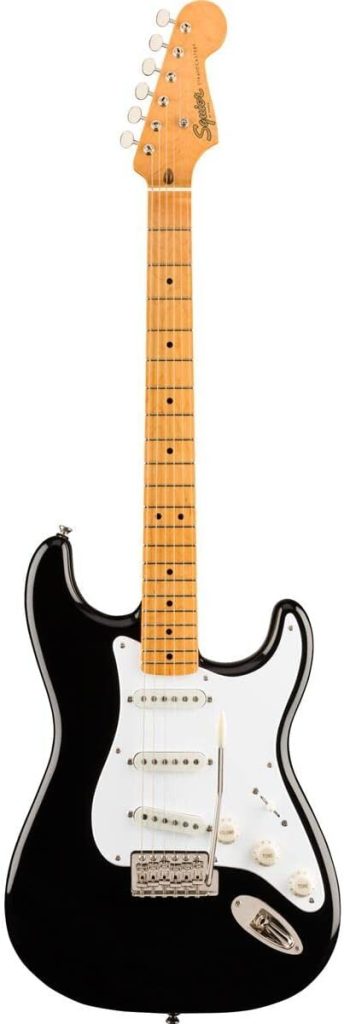
The Squier Classic Vibe series offers exceptional quality and vintage-inspired design at a price point suitable for beginners. The ’50s Stratocaster model features a comfortable C-shaped neck and three single-coil pickups that deliver versatile tones suitable for many genres.
Beginner-friendly features include:
- Vintage-tinted gloss neck finish for smooth playability
- Narrow-tall frets make bending strings easier
- Five-way pickup selector for tonal versatility
- Vintage-style tremolo for expressive playing techniques
Epiphone Les Paul Studio E1

The Epiphone Les Paul Studio E1 offers the iconic Les Paul design and tone at an accessible price point. With a mahogany body and pair of humbucker pickups, this guitar delivers the warm, thick tone that has defined countless rock recordings.
What makes it great for beginners:
- SlimTaper D profile neck is comfortable for new players
- Dual humbuckers provide noise-free operation and thick tone
- Lighter weight than traditional Les Pauls reduces fatigue during practice
- Excellent sustain and resonance motivate continued playing
Yamaha Pacifica PAC112V

The Yamaha Pacifica series has long been respected for offering exceptional value to beginning players. The PAC112V features a comfortable body shape, versatile HSS pickup configuration (one humbucker, two single-coils), and quality hardware that outperforms its price point.
Standout features for beginners:
- Versatile pickup configuration covers a wide range of tones
- Comfortable C-shaped neck suits various hand sizes
- Vibrato bridge allows for expressive techniques
- Solid alder body provides good resonance and balanced weight
Squier Affinity Telecaster

The Squier Affinity Telecaster delivers the distinctive tone and simple elegance of the classic Telecaster design. With two single-coil pickups and a fixed bridge, this guitar offers a straightforward, reliable platform for beginners.
Benefits for new players:
- Simple controls make it easy to focus on playing rather than settings
- Fixed bridge ensures excellent tuning stability
- C-shaped neck is comfortable for most hand sizes
- Versatile tone suits country, rock, blues, and more
Ibanez GRX70QA

The Ibanez GRX70QA combines eye-catching looks with features that appeal to beginners interested in rock and metal styles. With its quilted art grain top, humbucker/single-coil/humbucker pickup configuration, and tremolo bridge, this guitar offers impressive versatility.
Features beneficial for beginners:
- Fast, thin neck profile makes technical playing more accessible
- Humbuckers provide high-output tones perfect for heavier styles
- Tremolo bridge allows for expressive techniques
- Striking aesthetics inspire regular practice
Jackson JS Series Dinky JS11

For beginners drawn to metal and hard rock, the Jackson JS Series Dinky JS11 offers an affordable entry point to the world of shred guitars. With a comfortable super-strat body shape, thin profile neck, and high-output pickups, this guitar is built for speed and heavy tones.
What beginners will appreciate:
- Amaranth fingerboard offers smooth playability
- Dual high-output humbuckers deliver aggressive tones
- Lightweight poplar body reduces fatigue during practice
- 2-point fulcrum tremolo allows for dive bombs and other expressive techniques
Gretsch G2622 Streamliner
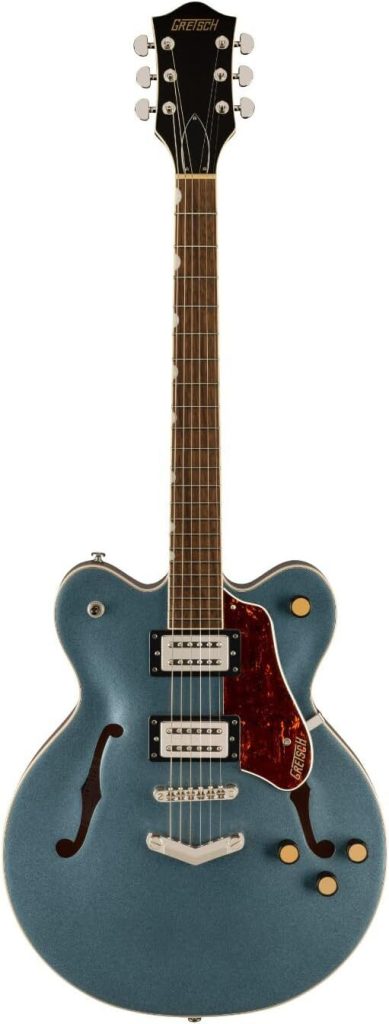
For beginners interested in classic rock, rockabilly, or jazz tones, the Gretsch G2622 Streamliner offers distinctive semi-hollow body construction and unique aesthetic appeal. Despite its vintage-inspired design, this guitar includes modern features that enhance playability for beginners.
Standout features include:
- Semi-hollow construction provides resonant, acoustic-like qualities
- Broad’Tron humbucking pickups deliver classic Gretsch tone
- Thin U-shaped neck profile is comfortable for beginning players
- Lightweight design reduces fatigue during practice sessions
Choosing Between Acoustic and Electric: Key Considerations
Now that we’ve explored some of the best options in both the acoustic and electric categories, let’s address the fundamental question many beginners face: Which type should you choose as your first instrument?
Learning Curve Comparison
One common misconception is that beginners should always start with acoustic guitars because they’re “more basic” or provide a better foundation. In reality, the best first guitar is the one that motivates consistent practice and aligns with your musical goals.
From a purely physical perspective, electric guitars typically offer these advantages for beginners:
- Lighter gauge strings require less finger strength
- Lower action (string height) makes fretting notes easier
- Thinner necks can be easier to navigate for players with smaller hands
- Less finger soreness during initial learning stages
However, acoustic guitars offer their own learning benefits:
- No additional equipment needed to start playing
- The challenge of playing an acoustic can build finger strength more quickly
- Greater focus on technique without effects to “hide” mistakes
- More immediate connection between playing technique and sound produced
Maintenance Requirements
Both acoustic and electric guitars require basic maintenance, but there are some differences worth considering:
Acoustic guitar maintenance typically involves:
- Regular string changes (every 1-3 months for regular players)
- Controlling humidity to prevent wood cracking or warping
- Occasional saddle and nut adjustments as the guitar ages
- Cleaning wood surfaces to prevent buildup of oils and dirt
Electric guitar maintenance may include:
- Regular string changes
- Occasional electronic maintenance (cleaning pots, checking wiring)
- Tremolo system adjustments (if applicable)
- Battery replacement for active pickups
- Cleaning the finish and electrical components
For absolute beginners, acoustic guitars generally require less technical knowledge to maintain in the short term, though both types benefit from periodic professional setups.
Amplification and Accessories
Another key consideration is the additional equipment required for each guitar type:
For acoustic guitars, essential accessories include:
For electric guitars, you’ll need:
The additional cost of an amplifier represents the most significant difference in startup expenses between the two options. However, many manufacturers now offer affordable starter packs that include everything a beginner needs to get started with an electric guitar.
Genre Versatility
Both acoustic and electric guitars can be used across various musical styles, but each has genres where they traditionally excel:
Acoustic guitars are traditionally associated with:
- Folk and singer-songwriter music
- Country and bluegrass
- Unplugged or acoustic rock
- Classical (nylon-string acoustics)
Electric guitars are commonly used in:
- Rock and metal
- Blues and jazz
- Pop and R&B
- Funk and soul
That said, many accomplished guitarists use both types of guitars, adapting their playing style to suit the instrument and musical context. As a beginner, choosing the type that best aligns with the music that inspires you will likely lead to more consistent practice and faster progress.
Essential Accessories for New Guitarists
Beyond the guitar itself, several accessories will enhance your learning experience and help protect your investment:
Tuners
A reliable tuner is perhaps the most essential accessory for any guitarist. Playing an out-of-tune guitar is discouraging and can develop bad habits as you try to compensate for incorrect pitches.
Options include:
- Clip-on tuners that attach to the headstock and sense vibrations
- Pedal tuners (for electric guitars)
- Smartphone tuning apps
- Online tuners accessible via computer or mobile device
For beginners, clip-on tuners offer an excellent balance of accuracy, convenience, and affordability.
Picks
Guitar picks come in various shapes, sizes, and materials, each offering different tonal characteristics and playing feels. As a beginner, it’s worth experimenting with several types to find what works best for you.
Common pick materials include:
- Celluloid: Traditional material with a warm tone
- Nylon: Durable with smooth release from strings
- Delrin/Tortex: Offers good grip and durability
- Ultem: Provides bright attack and excellent durability
Thickness also matters, with thinner picks (0.46-0.60mm) generally being easier for beginners to control for strumming, while medium picks (0.60-0.80mm) offer a good balance for mixed playing styles.
Straps
If you plan to play standing up at any point, a quality strap is essential. Even when seated, many players find that a strap helps stabilize the guitar in a comfortable playing position.
Look for:
- Adequate width to distribute the guitar’s weight comfortably
- Adjustable length to suit your height and preferred playing position
- Secure attachment points or additional strap locks for safety
Cases and Gig Bags
Protecting your investment with a suitable case or gig bag is highly recommended. Options range from lightweight gig bags to hard-shell cases offering maximum protection.
For beginners who primarily play at home, a quality gig bag often represents the best balance of protection, cost, and portability. Those who travel frequently with their instrument might consider investing in a hard-shell case for additional security.
Capos
A capo is a device that clamps across the guitar’s neck to raise the pitch of all strings simultaneously. This accessory allows you to change keys easily without learning new chord shapes, making it particularly useful for singers who need to adjust songs to suit their vocal range.
String Winders
While not essential, a string winder significantly speeds up the process of changing strings—a task you’ll perform regularly as a guitarist. These inexpensive tools can save time and frustration, especially for beginners still developing manual dexterity.
Guitar Stands
A quality guitar stand provides a safe place to keep your instrument when not in use but still want it readily accessible. Keeping your guitar visible and easy to grab encourages spontaneous practice sessions, potentially accelerating your progress.
Look for stands with:
- Padded contact points to protect your guitar’s finish
- Stable base that resists tipping
- Folding design if portability is important
Learning Resources for Beginning Guitarists
Once you’ve selected your first guitar, you’ll need quality learning resources to guide your development. Fortunately, today’s beginning guitarists have access to an unprecedented wealth of instructional content.
Online Lessons and Courses
The internet offers a vast array of guitar instruction, from free YouTube tutorials to comprehensive paid courses. Quality online resources for beginners include:
- Justin Guitar: Widely regarded as one of the best free online guitar courses, Justin Sandercoe’s methodical approach has helped countless beginners establish solid fundamentals.
- Fender Play: Fender’s subscription-based platform offers structured learning paths with high-quality video instruction and progress tracking.
- GuitarTricks: With thousands of lessons covering various styles and techniques, this platform provides a systematic approach to guitar learning.
- YouTube Channels: Channels like Andy Guitar, Marty Music, and Paul Davids offer excellent free content for beginners.
Mobile Apps
Numerous apps offer interactive guitar learning experiences:
- Yousician: Provides real-time feedback on your playing, gamifying the learning process.
- Ultimate Guitar: Offers the world’s largest database of guitar tabs and chords, plus a built-in tuner and other tools.
- ChordBank: Helps beginners learn and practice chord shapes with visual and audio references.
Traditional Methods
Despite the proliferation of digital resources, traditional learning methods remain valuable:
- In-person lessons: Working with a qualified instructor provides personalized guidance and immediate feedback that online resources can’t match.
- Method books: Classic guitar methods like Hal Leonard’s Guitar Method and Alfred’s Basic Guitar Method offer structured approaches to building fundamental skills.
- Playing with others: Joining a beginner guitar group or finding a more experienced mentor can accelerate learning and make the process more enjoyable.
Common Mistakes Beginners Make When Choosing Their First Guitar
Awareness of common pitfalls can help you avoid mistakes that might impede your progress or enjoyment:
Prioritizing Appearance Over Playability
While aesthetics matter—you should feel inspired when looking at your instrument—prioritizing looks over playability can lead to frustration. A visually striking guitar that’s difficult to play may end up collecting dust rather than fostering musical growth.
Buying Based Solely on Price
Both extremely cheap and unnecessarily expensive guitars can be problematic for beginners. The lowest-priced instruments often suffer from poor construction and setup issues that make learning more difficult, while high-end guitars represent an investment that may not be justified if you’re unsure of your long-term commitment.
Aim for the best-quality instrument that fits comfortably within your budget, recognizing that moderate improvements in quality often yield disproportionate benefits in playability and sound.
Ignoring the Importance of a Proper Setup
Even well-made guitars can be difficult to play if improperly set up. Issues like high action, sharp fret ends, or poor intonation can severely impact the learning experience. When possible, have any prospective guitar evaluated by an experienced player or technician, or purchase from retailers who provide setup services.
Choosing Based on Another Guitarist’s Recommendation
While recommendations from experienced players can be valuable, remember that comfort and playability are subjective. What works perfectly for one player might not suit another due to differences in hand size, playing style, or musical preferences.
Overlooking the Value of Trying Before Buying
Whenever possible, try multiple guitars before making a decision. Pay attention to how each instrument feels in your hands, how comfortable the neck is to navigate, and whether you find the sound inspiring. These subjective factors can significantly impact your motivation to practice regularly.
Caring for Your New Guitar
Proper maintenance ensures your first guitar remains playable and retains its value over time. Here are essential care guidelines for beginners:
Basic Cleaning Practices
Establish a routine of wiping down your guitar after each playing session:
- Use a soft, lint-free cloth to remove finger oils and sweat from the strings and fretboard
- For more thorough cleaning, use products specifically designed for guitar finishes and fretboards
- Keep the headstock area clean to prevent buildup around tuning machines
Humidity Considerations
Wood instruments are particularly sensitive to environmental conditions:
- Acoustic guitars ideally should be kept in environments with 45-55% relative humidity
- In dry climates or during winter heating seasons, consider using a humidifier in your guitar case
- In extremely humid environments, dehumidifiers or desiccants can help prevent issues
String Changing Basics
Regular string changes maintain optimal tone and playability:
- For regular players, changing strings every 1-3 months is typically recommended
- Learn proper string changing technique to avoid damaging the guitar or causing tuning instability
- Consider slightly lighter gauge strings when first starting out to reduce finger soreness
Storage Recommendations
Proper storage protects your investment:
- Store your guitar in its case when not being used for extended periods
- Avoid leaving the instrument in direct sunlight, near heating vents, or in extremely cold areas
- If using a stand, position it away from high-traffic areas to prevent accidental bumps or knocks
Finding Your Sound: Developing as a Guitarist
As you begin your journey with your first guitar, remember that finding your unique voice as a player takes time and experimentation:
Embracing the Learning Process
Learning guitar is a progressive journey marked by both achievements and challenges. Approach the process with patience and celebrate small victories along the way. Regular, focused practice will yield more significant results than occasional marathon sessions.
Exploring Different Techniques
Don’t limit yourself to a single playing approach. Experiment with:
- Fingerstyle and flatpicking techniques
- Various strumming patterns
- Basic lead guitar concepts
- Different picking hand positions
This exploration will help you discover which techniques resonate most strongly with your musical sensibilities.
Building a Foundation of Fundamentals
While it’s tempting to jump immediately to playing favorite songs, investing time in fundamental skills pays long-term dividends:
- Mastering basic chords and transitions
- Developing consistent rhythm and timing
- Understanding simple music theory concepts
- Training your ear to recognize pitches and intervals
These foundational elements will support everything else you learn on the instrument.
Conclusion: Making Your Decision
Choosing your first guitar represents the beginning of a potentially lifelong musical journey. By considering the factors discussed in this guide—from body style and playability to your musical goals and learning environment—you’ll be well-positioned to select an instrument that supports and inspires your development as a guitarist.
Remember that while this guide provides a framework for decision-making, the “right” guitar is ultimately the one that motivates you to practice consistently. Trust your instincts about which instrument feels and sounds right to you, as your personal connection with the guitar will be a significant factor in your learning success.
Whether you choose an acoustic or electric model, from the recommendations listed here or another quality option that speaks to you, the most important step is to begin your musical journey. With patience, persistence, and regular practice, you’ll develop the skills to express yourself through this incredibly versatile and rewarding instrument.
The guitar has inspired countless musicians across generations and musical boundaries. Now it’s your turn to add your voice to that rich tradition.
Disclaimer: As an Amazon Associate, I earn from qualifying purchases. All product recommendations are based on research and experience rather than direct testing of every instrument mentioned. Specific prices have been omitted as they vary by retailer and change over time.

